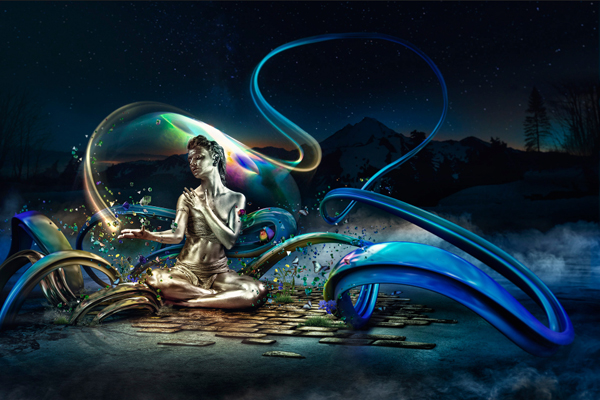
There has been another spark ignited on the SOOC debate recently, if you don’t know what the SOOC debate is good for you, you may want to stop reading now before you get dragged in…. The SOOC debate is all about should a light painting be “Straight Out Of Camera”, or is some editing of the image OK and if so what does “some” mean… when is it not a light painting anymore? My personal opinion is any photograph is always best to get it right when you shoot it, that is what I personally strive for in my light paintings, but really you can do whatever the hell you want! I just don’t think you should say you created an image entirely in the camera if you added a bunch of layers to it in photoshop or some other digital editing program. I know some LP’s label their shots No Photoshop but tweak them to death in Lightroom, so does that deserve a no PS label?
On the other end of the spectrum, Light Painting Photographer Eric Paré Teamed up with digital artist Mike Campau to create a f@#*ing awesome new light painting project (image above) that is SOOC, (straight out of computer), see what I did there… There is no way an image like the edited version of this one could have ever been achieved SOOC, unless maybe your TCB and even with his skill set it would still be pretty difficult. Because this image is out of the computer does that make the light painting part of it any less awesome?
The debate about if a light painting should or should not be edited will rage for at least a little while longer, but as light painting grows and new projects like this one come out opinions will change, or not. Check out the before and after, the BTS video below that shows how much work went into creating the final image, and feel free to post your thoughts in the comments section so we can all look back and laugh 5 years from now…


Jason Thomas Borneman says
Great article! My take is that I think it’s not only funny, but nonproductive to put rules on art, especially when you are creating something the masses just can’t wrap their heads around. I understand peoples opinions on SOOC but that’s just what they to me, opinions. The collaboration of art made here is full of skill, time, and creativity. I also like how you brought up tcb. I’ve been lucky enough to explore and create with Dana Maltby/tcb and I have to agree, if there is someone that can make something like this happen without photoshop, it’s him. He in an innovator in many ways, from his handmade tools, to triple exposed film, used in 3 different cameras. It’s rare I get to meet someone so dedicated to their craft, and to be so widely versed in skill sets. He has become a great inspiration and I’m really stoked we live so close. He really helped me focus back on what is important, and to me that’s staying true to your art, and what you want to create for the sake of art and not to get “likes” on facebook.
Christina Salinas says
I personally, think that Photoshop is a very powerful tool that should be used when it is apporpriate for the final vision of the image, whatever that might be!! I would love to see a contest category that says…must use photoshop to manipulate the image in a creative way…the possibilites would be endless!
Jason says
Christina your in luck! Check out this link https://www.facebook.com/media/set/?set=a.283152521850665.1073741840.118232615009324&type=1
its too a design contest where users submit there own designs using the image above.
Eric Paré says
haha exactly what I was about to say. Check this out : https://www.facebook.com/tencol.lection/app_566715063411955
many cool prices to win!
MarcBB says
What an idea for a post, Jason 😉
Hob has so eloquently repled, I will add my thoughts nonetheless…
So “Straight out of Camera”.
SOOC – “I converted the RAW file I shot it in to .jpeg”
SOOC – “1 exposure, uploaded to the internet, nothing else done.”
SOOC – “I used image overlay in camera, essentially layering 2 images together…but it came out of the camera so it’s SOOC”
SOOC – “I used Lightroom and or Photoshop to add contrast / saturation etc after the event”
…and so on.
It means different things to different people.
Your average Joe cares not about SOOC as they think it’s been done in Photoshop anyway (hence the need to inform). As SOOC means different things to different people and ultimately only appears to matter to other light painters, IMO, the only purpose it serves is to show that you didn’t digitally create your orb and pass it off as light painting. After all, who cares if you added some contrast or saturation to make your image more like what you set out to create in the first place? If it makes you happy, or your target audience, then that’s all that matters.
Jason Thomas Borneman says
Well put!